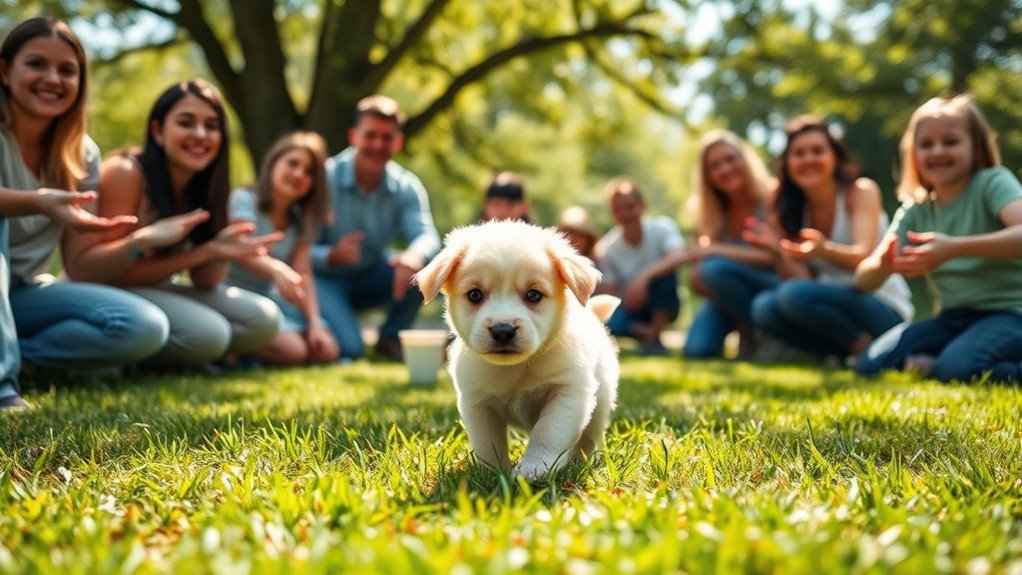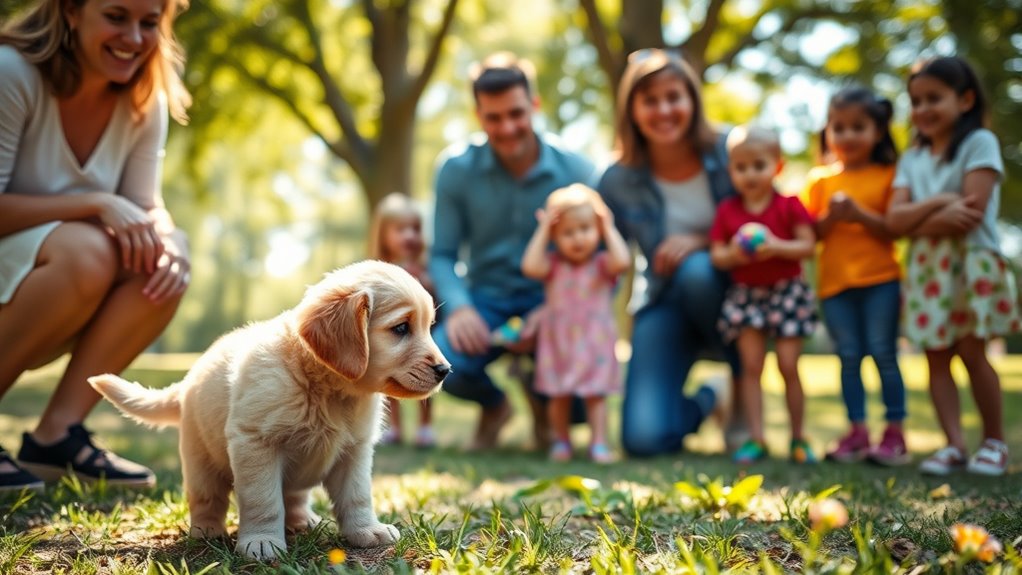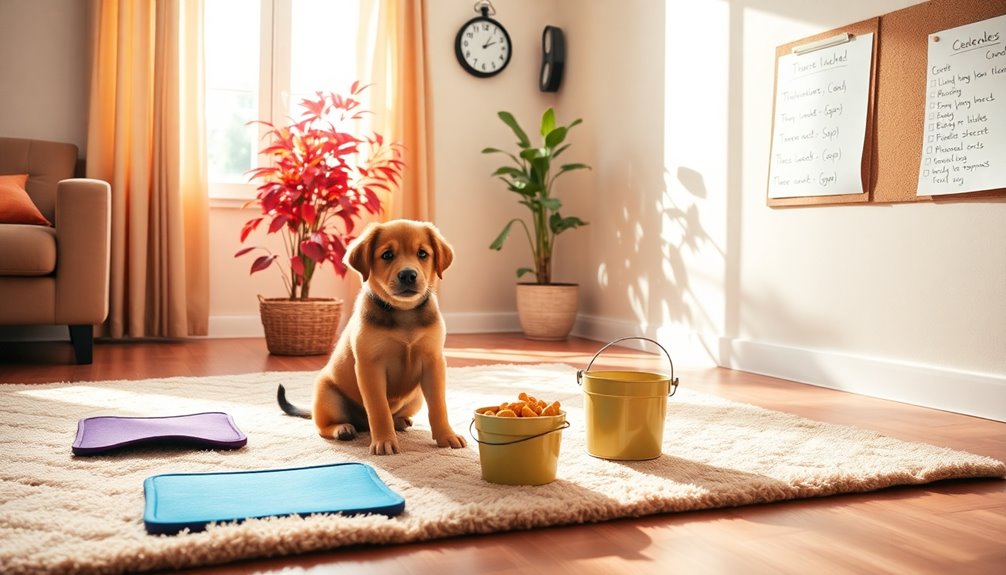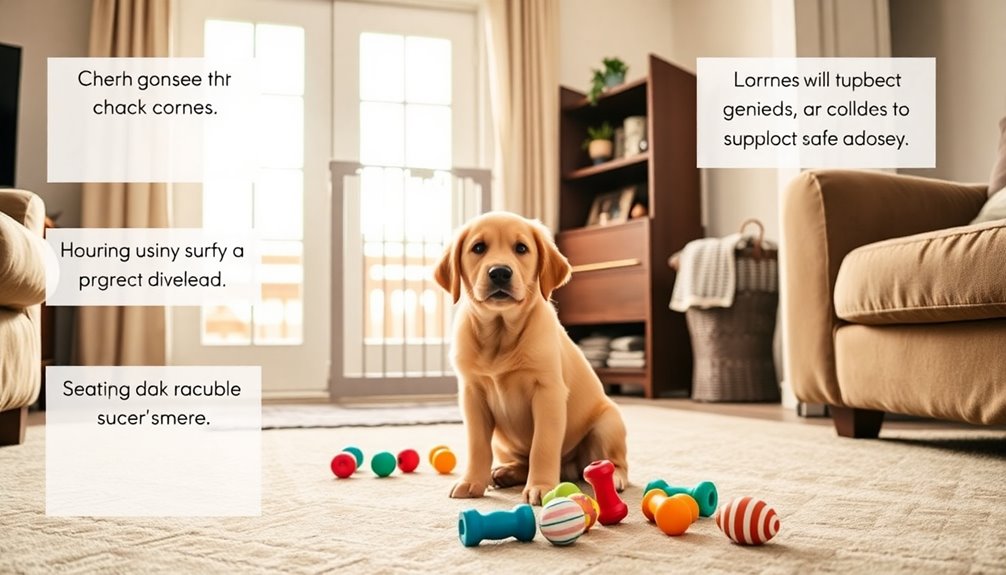To introduce your puppy to the world safely, start with controlled playdates with calm, friendly dogs of similar size. Keep sessions short, positive, and watch for signs of stress or fear. Use treats and praise to reinforce good behavior and build their confidence gradually. Always support your puppy’s emotional needs and avoid forcing them into uncomfortable situations. Staying consistent and gentle helps them develop trust and resilience—more tips await if you keep exploring.
Key Takeaways
- Start socialization early with calm, friendly dogs in controlled environments to build trust and positive associations.
- Keep puppy playdates short, positive, and gradually increase duration to prevent overwhelming your puppy.
- Observe body language for signs of stress, calmly remove the puppy if they show fear or discomfort.
- Consistently expose your puppy to new people, animals, and environments at their comfort level for steady confidence growth.
- Reinforce positive interactions with treats and praise to foster emotional security and resilience in new situations.

Have you ever wondered what truly makes someone socially confident? It’s often the result of positive experiences, early exposure, and the ability to handle fears effectively. The same principles apply when you’re introducing your puppy to the world. Socialization isn’t just about letting your puppy meet other dogs; it’s about creating a foundation of comfort and trust that lasts a lifetime. One excellent way to do this is through puppy playdates. When you arrange these playdates, you help your pup learn how to interact with different dogs in a controlled environment. Start with calm, friendly dogs that match your puppy’s size and energy level. Keep the sessions short and positive, gradually increasing the duration as your puppy grows more comfortable. During these playdates, pay close attention to your puppy’s body language. If they show signs of fear or stress—such as tucked tails, growling, or trying to retreat—take a step back. Handling fears is a vital part of socialization, and your role is to support your puppy through those moments. When your puppy encounters something intimidating, don’t force them into the situation. Instead, calmly remove them and give them time to recover. Use treats and praise when they handle new experiences well, reinforcing a sense of security. Over time, this approach helps your puppy develop resilience and confidence, making future social encounters easier. Remember, socialization isn’t a one-time event; it’s an ongoing process. Consistency is key, so keep exposing your puppy to new environments, people, and other animals in a gradual and controlled manner. Always be mindful of their comfort levels, and never push them into situations that cause overwhelming fear. As they learn to handle fears and meet other dogs in a positive way, you’ll notice their confidence build naturally. This will translate into a well-adjusted, sociable dog who feels safe exploring the world around them. The journey of socialization is about building trust and resilience step by step. With consistent effort and a caring approach, you’ll help your puppy become a dog who’s not just friendly, but also confident in any situation they face. Additionally, understanding the importance of dog training schools can provide extra support and guidance during this crucial developmental stage.
Frequently Asked Questions
When Is the Best Time to Start Socializing a Puppy?
You should start socializing your puppy early, ideally between 3 and 14 weeks old, aligning with key Puppy milestones. This period is vital in the Socialization timeline, as puppies are most receptive to new experiences now. By gradually exposing them to different people, animals, and environments, you help prevent future fears and build confidence. Don’t wait—early socialization creates a well-adjusted, happy adult dog.
How Do I Socialize a Shy or Anxious Puppy Effectively?
To socialize a shy or anxious puppy, you should start with gradual exposure to new people, animals, and environments, taking it slowly to avoid overwhelming them. Use positive reinforcement like treats and praise to create a positive association with new experiences. Keep sessions short and calm, and always respect your puppy’s comfort level. Over time, this approach helps build their confidence and trust, making socialization easier and more effective.
Can Socialization Harm a Puppy With Health Issues?
Think of socialization as planting seeds in a delicate garden; for a puppy with health issues, you must tread carefully. While socialization risks exist, gentle exposure tailored to your pup’s puppy health can help them thrive without harm. Avoid overwhelming situations, and consult your vet. With patience, you’ll nurture confidence while protecting their well-being, ensuring your puppy blossoms safely into a well-adjusted companion.
What Are Signs of Overstimulation During Puppy Socialization?
During puppy socialization, you should watch for signs of overstimulation, like yawning, lip licking, or turning away, which indicate your pup needs a break. Calmness cues such as relaxing, resting, or seeking your attention show they’re ready to pause. Recognizing these signs helps you prevent stress and make sure positive experiences, making socialization enjoyable and safe for your puppy’s development.
How Do I Handle Socialization Setbacks or Fears?
Did you know that over 60% of puppies experience behavioral setbacks or fears during socialization? When facing these challenges, stay calm and patient. Use positive reinforcement to encourage brave behavior and gradually reintroduce your pup to the fearful situation. Focus on fear management by creating a safe, low-pressure environment. Consistent, gentle exposure helps build confidence, turning setbacks into opportunities for growth and stronger trust between you and your puppy.
Conclusion
By following these socialization secrets, you’ll help your puppy grow into a confident, well-adjusted dog. Imagine introducing your pup to a busy park; if done gradually and positively, they’ll learn to enjoy new experiences instead of fearing them. For example, Sarah’s puppy, Max, once nervous around other dogs, now happily plays with friends after consistent socialization. Remember, patience and positive reinforcement are your best tools—your efforts will shape a happy, social pup for years to come.










